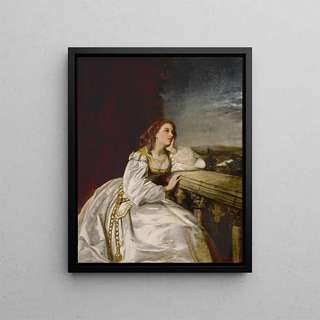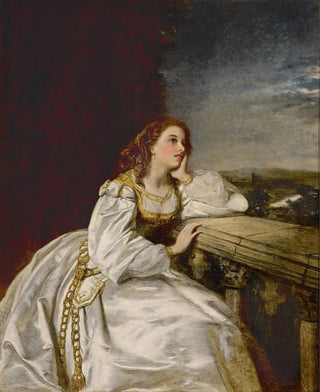Art print | Juliette : Oh, que je sois un gant sur cette main - William Powell Frith


View from behind

Frame (optional)
William Powell Frith's artwork "Juliette: Oh, that I were a glove on this hand" is an iconic piece that captures the very essence of passion and desire. Inspired by Shakespeare's famous scene from Romeo and Juliet, Frith manages to transcend the simple narrative framework to immerse the viewer in a moment of profound intimacy and emotional tension. The artist, through his skillful play with light and expressions, succeeds in making the characters' souls vibrate, inviting us to feel the fervor of their feelings. This work, a true ode to love, transports us to a universe where every exchanged glance and delicate gesture tells a timeless story.
Style and uniqueness of the work
Frith's style is distinguished by exceptional meticulousness and attention to detail, which confer an unparalleled visual richness to his works. In "Juliette: Oh, that I were a glove on this hand," vibrant colors and carefully crafted textures create an almost palpable atmosphere. The contrast between shadow and light enhances the depth of emotions, while the poses of the characters, both natural and theatrical, capture the intensity of their connection. Every element, from the setting to the clothing, has been carefully selected to strengthen the visual narrative, making this piece not only an artistic representation but also an open window into the Victorian era, its customs, and passions.
The artist and his influence
William Powell Frith, a major figure in 19th-century British painting, became known for his ability to depict scenes of everyday life with photographic accuracy. His work, often imbued with striking realism, is part of a tradition that values meticulous observation of human behavior. Frith captured the essence of social relationships of his time, and "Juliette: Oh, that I were a glove on this hand" is a perfect example. The artist's influence extends far beyond his own creations, inspiring many contemporary and future painters to explore themes of love, drama, and human interactions through a refined lens.

Matte finish

View from behind

Frame (optional)
William Powell Frith's artwork "Juliette: Oh, that I were a glove on this hand" is an iconic piece that captures the very essence of passion and desire. Inspired by Shakespeare's famous scene from Romeo and Juliet, Frith manages to transcend the simple narrative framework to immerse the viewer in a moment of profound intimacy and emotional tension. The artist, through his skillful play with light and expressions, succeeds in making the characters' souls vibrate, inviting us to feel the fervor of their feelings. This work, a true ode to love, transports us to a universe where every exchanged glance and delicate gesture tells a timeless story.
Style and uniqueness of the work
Frith's style is distinguished by exceptional meticulousness and attention to detail, which confer an unparalleled visual richness to his works. In "Juliette: Oh, that I were a glove on this hand," vibrant colors and carefully crafted textures create an almost palpable atmosphere. The contrast between shadow and light enhances the depth of emotions, while the poses of the characters, both natural and theatrical, capture the intensity of their connection. Every element, from the setting to the clothing, has been carefully selected to strengthen the visual narrative, making this piece not only an artistic representation but also an open window into the Victorian era, its customs, and passions.
The artist and his influence
William Powell Frith, a major figure in 19th-century British painting, became known for his ability to depict scenes of everyday life with photographic accuracy. His work, often imbued with striking realism, is part of a tradition that values meticulous observation of human behavior. Frith captured the essence of social relationships of his time, and "Juliette: Oh, that I were a glove on this hand" is a perfect example. The artist's influence extends far beyond his own creations, inspiring many contemporary and future painters to explore themes of love, drama, and human interactions through a refined lens.






